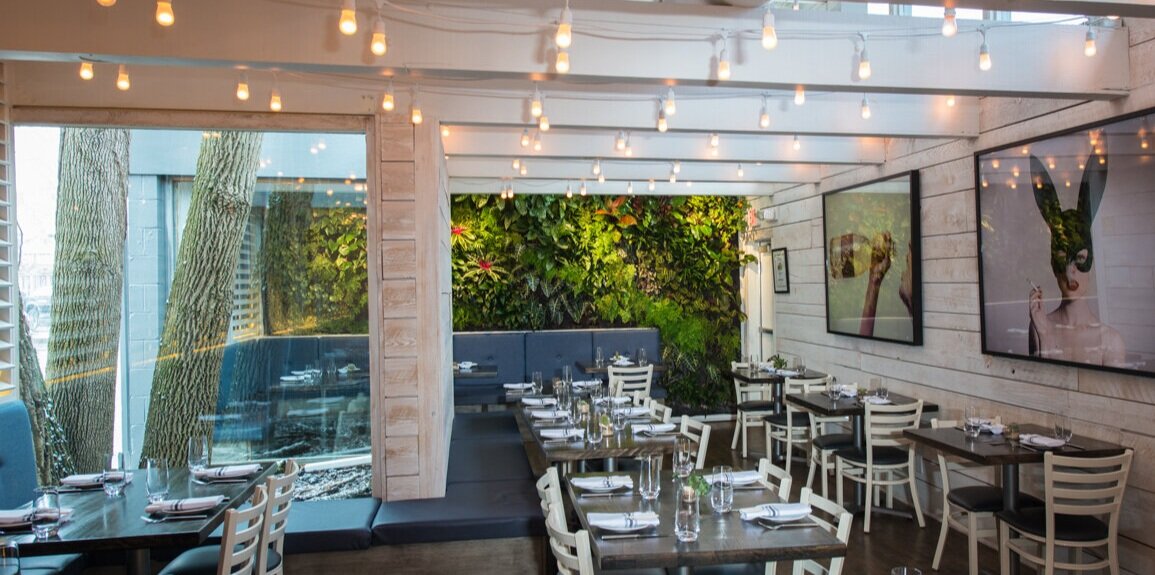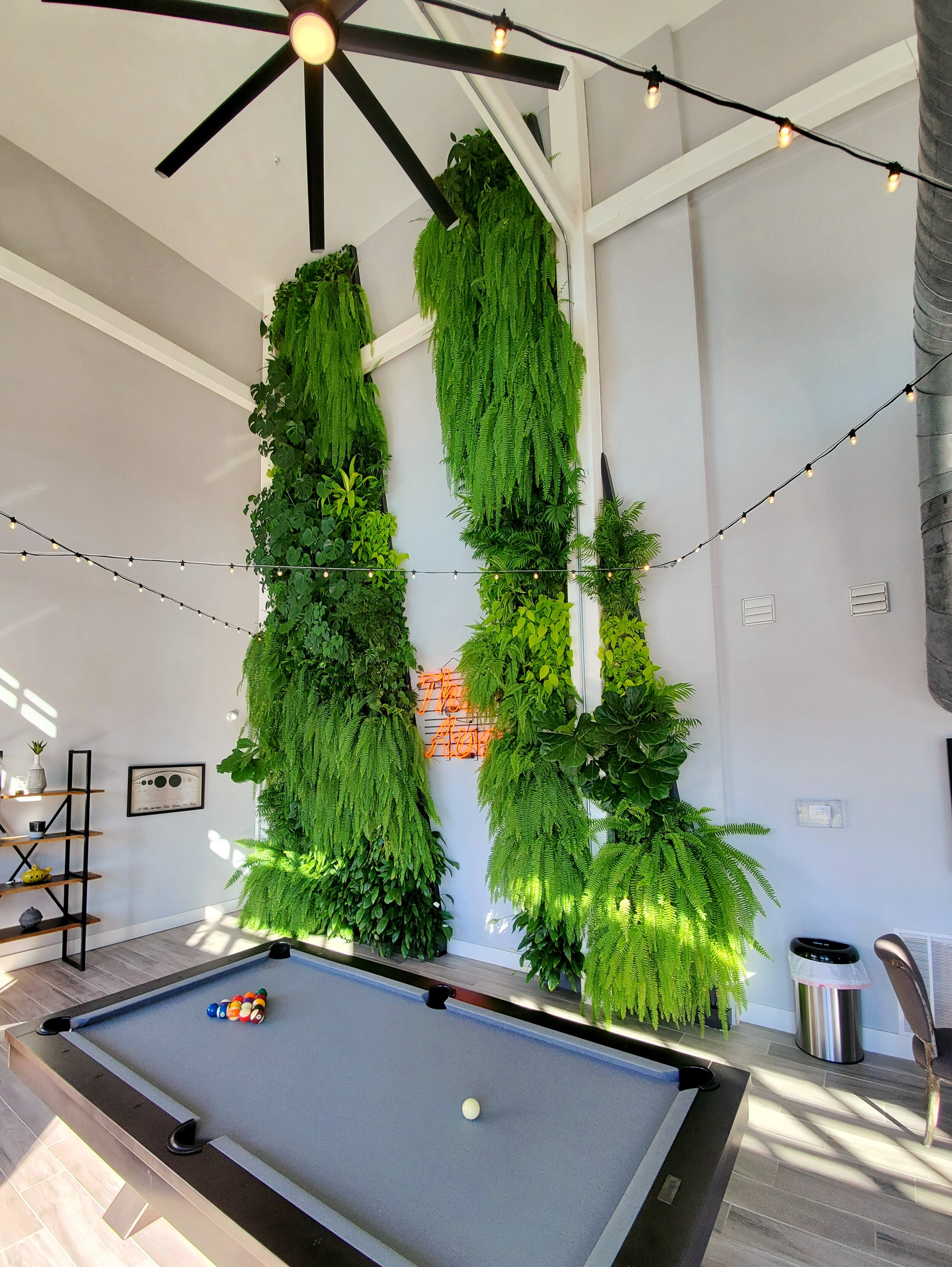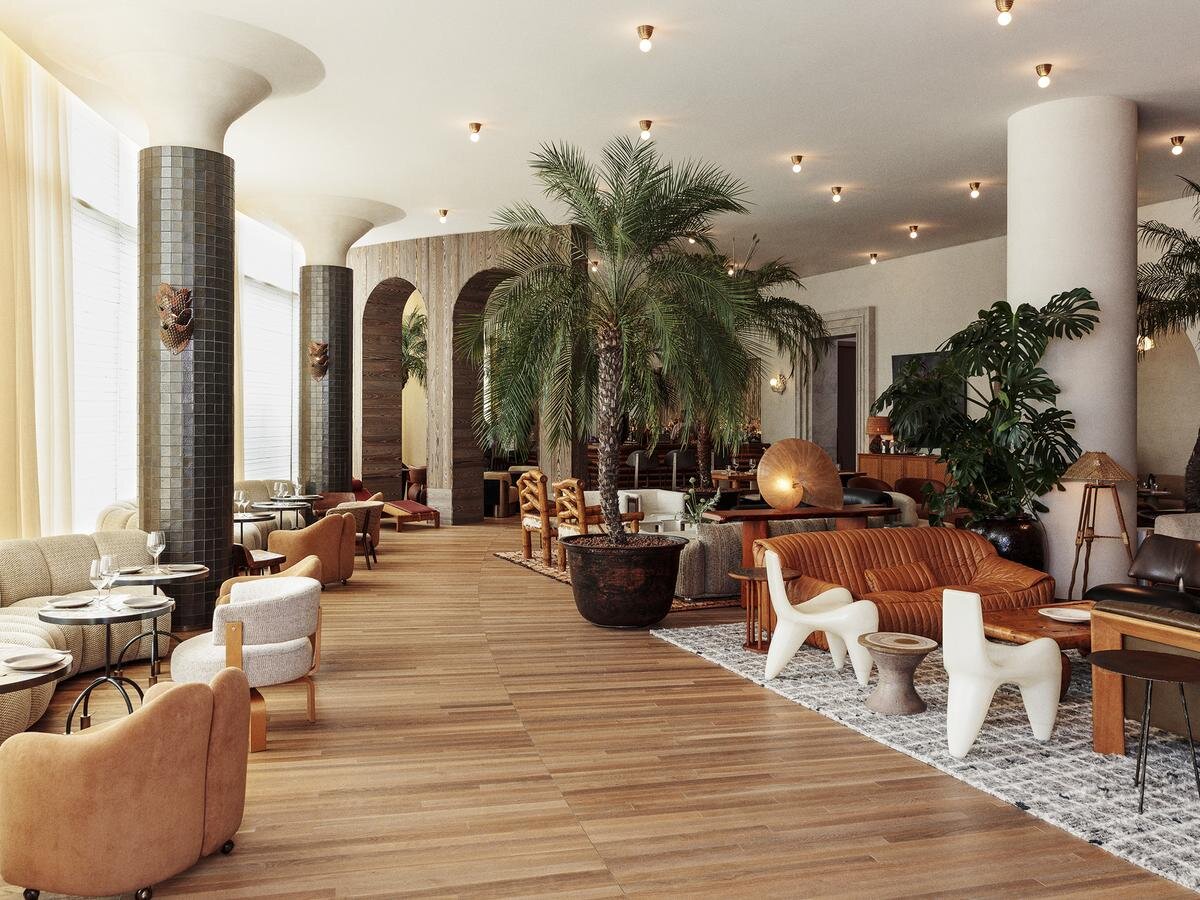Elements of Biophilic Design - Direct Experience of Nature
E + O Kitchen, Cincinnati OH - Living Wall Designed by Urban Blooms
Biophilic design can be seen as a multifaceted, environmentaly-based approach to solving problems that exist in current architecture and interior design. For centuries we have been trying to escape the wilderness, and provide peace of mind to humans who inhabit spaces in which they live, work, and simply exist in. This has always been a double-edged sword. Humans have an innate and instinctive urge to feel connected to the natural world. While in the past we had to compromise between the two, today we find ourselves at the beginning of a renaissance in which human-inhabited structures can provide safety while still experiencing the benefits that the incorporation of nature provides to our mental and physical health. Throughout history, we have seen forward thinkers who build structures that create harmony within their specific environment, but more and more often we see structural and interior designs that overlook our instinctual urge to connect with our environment.
Biophilic design is a concept that attempts to integrate natural elements into buildings and structures to enhance the benefits that nature provides humans. The concept is an integrated part of sustainable design that works harmoniously with low impact design practices. While many aspects go into creating biophilic interior and exterior structure, this concept can be broken down into three elements which provide a better understanding of the attributes that should be achieved when creating designs. The elements include: Direct Experience of Nature, Indirect Experience of Nature, and Experience of Space and Place. Today, we will dive into the attributes that make up the first element, Direct Experience of Nature.
Direct Experience of Nature – The 9 Attributes
1. Light
The amount of light that is available at any certain time is one of the first things we evaluate when stepping into a room or building. We all notice when the area we are in feels dark, dingy, and cut off from the rest of the world. The light a space has directly impacts us in several ways. Light has been found to directly impact a human’s circadian rhythms, as well as affect us spatially and temporally. This means a lack of light can have adverse effects on people’s mental and physical health. It is no wonder that more and more modern architectural structures consist of large glass windows and walls that provide those occupying the space direct and indirect amounts of light being sourced from the outside. Increasing the amount of widows/glass walls is not the only solution. Clerestories, Skylights, Atria, Reflective Materials, Sun tracking mirrors, and Fiber optic cables can all be seen as modern solutions to how architects and interior designers incorporate the biophilic attribute of light into their work.
2. Air
Unlike light, we may not notice how air quality affects us unless we experience one extreme or the other in terms of that quality. This can go without being said, but air quality is extremely important for the simple fact that we all have to breathe to live! Mind-blowing… I know. Something that may not be as obvious is that air quality can affect everything from our sense of touch, smell, taste, and level of awareness.
Constant exposure to processed atmospheric air conditions can increase fatigue, diminish morale, and compromise our physical health performances. Well thought out biophilic design tries to combat these things by emphasizing the importance of operable windows, vents, narrower rooms and structures, chimney stack effects, and increasing access to outside through balconies, porches, and decks. This helps provide more natural flowing air streams that help distribute and recycle the air within a specific area, as well as provide occupants with options for fresher air that comes from outside.
University of Nottingham, Jubilee Campus “Image by Magnus Manske via Wikimedia”
3. Water
The importance and benefits that come with incorporating water into design can often be overlooked. Water is viewed as a practical element in structures that we use to wash our hands, or fill a coffee pot, but is not acknowledged for the therapeutic benefits it can provide when incorporated into the designed environment. The ability to experience water in a way that feels natural and not exploitative can be provided through incorporating fountains, constructed wetlands, ponds, swales, waterfalls, rainwater spouts, and aquaria into building design. Overlooking the integration of water into architectural and interior design may not have the adverse side effects that come with ignoring other attributes of direct experiences to nature such as light and air, but ignoring it causes us to miss out on the benefits that it brings!
The incorporation of water into the environmental design of a building can increase stress relief, enhance performance, and improve problem solving and creativity. Biophilic design is meant to optimize human’s experience and connection to nature, not just minimize the adverse effects that our buildings and structures create. Reshaping how we view and interact with our environment is a fundamental ideology of biophilic design.
4. Plants
Plant lovers are mainstream now, and for good reasons! Plants have the ability to purify the air, create ambient sound and temperature in a variety of settings, and hold an abundance of mental health benefits for people surrounded by them. Using the attribute of plants to maximize the benefits of biophilic design is what Urban Blooms knows how to do best. The inclusion of well designed, ecologically intact plant features such as living walls and green roofs provide people occupying the area to feel an increase in comfort, health, productivity, performance, and can even minimize the effects of stress. Ways to optimize the experiences gained from biophilic design features such as plant walls would be to integrate native plant varieties in the wall, and to use innovative techniques that assure sustainability and easy maintenance. Urban Blooms has a large portfolio of examples of how we have successfully incorporated plants into a variety of different settings to maximize the benefits that biophilic design provides.
The Avenue Apartments, Columbus OH - Living Wall Designed by Urban Blooms
5. Animals
The inclusion of animals as an attribute of the direct experiences of nature can be considered ethically problematic when applied to the design of buildings and other spaces. The way that we have to think about incorporating animals into architectural and interior design has to be more abstract. The pragmatic approach that is taken when incorporating this attribute into design would be to focus on how the design of outdoor landscapes inhibits and encourages animal life. Incorporating ponds, feeders, aviaries, gardens, and aquaria into outdoor areas creates friendly, non-hostile spaces for animal life to exist while minimizing the presence of ethical dilemmas. On the flip side, when attempting to incorporate animal attributes into interior structures it is best to rely on imagery of animals, and not living animals themselves.
While it may be more difficult to include this attribute successfully and ethically, the mental health benefits that it provides consist of an increase in creativity, pattern recognition, companionship, and empathy.
6. Fire
Throughout time, man has been on a continuous quest to harness the power of fire. With modern technologies and innovation, the quest could be considered a closed case, but often in modern structures the experience that fire provides has been diminished and depreciated. The way that the application of biophilic design tries to solve this issue is by encouraging design that highlights, rather than conceals, the properties of fire. Fire has an amazing ability to spark human creativity, imagination while providing a relaxing environment to those who come across it. Things such as heating, cooking, and energy production are all ways in which we harness fire in our modern lives, and are ways we can highlight the beauty of the element.
7. Landscape
Landscapes are an attribute of direct experiences of nature that you may see incorporated into modern design more than some of the other attributes. While this is beneficial in creating awareness of what biophilic design is and how different attributes can be used, often the incorporations of landscapes are executed poorly. Landscapes are regularly designed using too many artificial materials, and man-made products including fake rocks, fake wood, and other d elements that are obviously artificial. Another downfall of many landscapes is the use of non-native plant species which can create a sense of falsehood for those that interact with it. The way biophilic design encourages landscapes to be created is by incorporating a variety of native plants, water, and natural terrain all in a way that is self-sustaining, and ecologically coherent. Creating a better thought out landscape also means developing it in a way that allows humans to interact with the landscapes. This can be accomplished by creating pathways, viewing areas, and observational platforms. When executed properly, the incorporation of landscapes into the design of structures can provide people with benefits that range from increased comfort, attention, productivity, and the feeling of safety.
Proper Hotel, Santa Monica CA - Designed by Kelly Wearstler
8. Weather
Historically, the hardships that weather has brought upon humans incentivized the development of structures that became better and better at protecting us from the unpredictable and sometimes destructive forces that weather has on humans. While it is undoubtedly important for the structures we build to provide protection from destructive weather forces, today we recognize that weather affects us in powerful instinctual ways that we can benefit from. Human response to sunshine, rain, wind, temperature, and other meteoroidal conditions remains deeply embedded in biology and consciousness. Biophilic design practices acknowledge this and create architecture and interior design that feature operable windows, views, porches, balconies, decks, terraces, courtyards, and transparent roofs.
9. Views
The accessibility to view nature from indoor environments can be seen to affect human imagination, the feeling of safety, and relaxation. The effects that this attribute has come as no surprise considering the way views of nature affect human physical and mental health has been the topic of several case studies, especially with the focus on how it affects patients in healthcare settings. Having access to these views is only the first step. Biophilic design attempts encourage the creation of structural design both externally and internally that creates ties to the natural environment. Playing off of the natural views that will be seen from a structure or facility allows the creation of a unified streamline design. Examples of how to do this consist of extending the impact of views of nature relatively to moderate to short distances, modest heights, and from sheltered spaces.
Fallingwater House - Designed by Frank Lloyd Wright
Summary
Direct experience of nature is the first element of biophilic design, and also the most straightforward approach to accomplishing various levels of sustainable and functional design concepts. It consists of 9 attributes that include light, air, water, plants, animals, fire, landscape, weather, and views. Designing and implementing biophilic design elements into both the exterior and interior layout of structures is no small feat. The nine elements listed above only break the surface. While it may seem overwhelming, it is important to remember that our ability to connect with nature is innate. To master biophilic design is to not only have an understanding of how each attribute contributes to the collective concept, but also to become in tune and observant of how nature benefits us and our creative processes.




